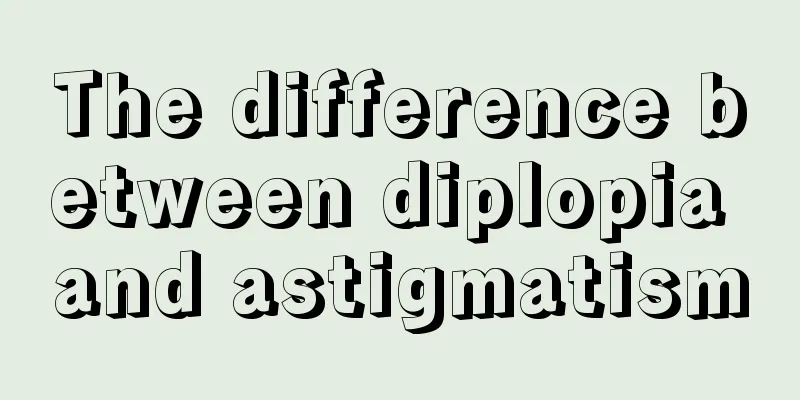The difference between diplopia and astigmatism

|
In the past, most people who were nearsighted lived in poor conditions, with light bulbs of low power and insufficient brightness. Living in such an environment for a long time could easily lead to myopia. Myopia may sometimes cause strabismus, astigmatism, diplopia, etc. Once the above situation occurs, it will be difficult to restore the vision of the eyes. This will not only bring certain troubles to your life, but will also cause headaches for a long time and affect your work and study. Visual acuity loss is closely related to the degree and type of astigmatism. People with mild astigmatism usually have normal vision, while those with moderate or high astigmatism have poor vision at both far and near distances. Simple astigmatism will cause a slight decrease in vision, while compound astigmatism and mixed astigmatism will cause a significant decrease in vision. If it is not properly corrected, amblyopia may occur. Diplopia refers to the abnormal phenomenon that when both eyes look at one object, they see two images. There are many causes of diplopia, and diseases of the cranial nerves or the brain itself may cause diplopia. If one or more of the six muscles that control eye movement become inflamed, traumatized, or have neurological disorders, the muscle movements of both eyes will become uncoordinated and diplopia may occur. For monocular diplopia, the cause of the eye disease should be identified and treated; for binocular diplopia, glasses, medication or surgery can be used as appropriate. Monocular diplopia requires finding out the cause of the eye disease and treating the eye disease, such as wearing glasses or performing cataract removal surgery. There are four treatment options for binocular diplopia: (1) Wearing glasses: For small-angle eye deviation, wearing glasses can alleviate the symptoms. (2) External eye muscle weakness or paralysis leads to: Treatment of myasthenia gravis. (3) Cranial nerve or brain lesions: drug treatment or surgical operation, such as brain tumor removal. (4) Eye muscle surgery: to correct strabismus or to reposition extraocular muscles that are stuck after trauma. Astigmatism is an abnormal refractive error of the eye and is related to the curvature of the cornea. When parallel light rays enter the eye, they cannot be focused on one point (focus) due to the different refractive powers of the eyeball on different meridians, and thus cannot form a clear image. This situation is called astigmatism. Astigmatism cannot form a clear image by using accommodation or moving the distance between the target and the eye. Only by wearing a suitable cylindrical lens can a clear image be formed on the retina. According to the form of manifestation, astigmatism can be divided into regular astigmatism and irregular astigmatism. The former can be corrected with lenses, while the latter cannot be corrected with lenses. Astigmatism Treatment Including optical correction treatment and surgical treatment. Optical correction with cylindrical lenses is the main treatment for astigmatism. 1. Regular astigmatism Different cylindrical lenses can be used to correct astigmatism according to the type and degree of astigmatism. Use convex cylindrical lenses for hyperopic astigmatism and concave cylindrical lenses for myopic astigmatism. Mild astigmatism does not need to be corrected if there are no clinical symptoms. However, if there is decreased vision or symptoms of visual fatigue and visual interference, corrective glasses should be worn. Children, especially preschoolers, must fully correct astigmatism to prevent the formation of amblyopia. Before wearing glasses, you should undergo retinoscopy, and children and adolescents should undergo mydriasis refraction. You can also combine it with keratometer measurement to understand the true nature and degree of astigmatism, and then combine it with subjective trial glasses to determine the prescription. People with high astigmatism who cannot adapt to frame glasses can choose contact lenses for correction. 2. Irregular astigmatism If it is difficult to correct with lenses, it can be corrected with contact lenses. 3. Surgery It is suitable for congenital or acquired high astigmatism caused by eye surgery such as cataracts or corneal transplantation, such as excimer laser refractive corneal surgery, laser keratoplasty, keratotomy, etc. |
<<: Contact lenses with astigmatism
>>: High myopia plus high astigmatism
Recommend
What to do if your voice becomes hoarse
A deepening voice should be a sign of voice chang...
Question: What are the symptoms of advanced bladder cancer?
Bladder cancer is a malignant tumor that originat...
What is the function of disposable activated carbon mask
The so-called disposable activated carbon mask is...
Lumbar puncture positioning
Some neurological diseases cannot be diagnosed di...
The harm of bone cancer to patients
For patients with bone cancer, active treatment i...
How to completely cure glioma
Glioma is a tumor that occurs in the neuroectoder...
Six health dogmas that can be broken
There’s no need to obsess over healthy habits tha...
How long to cook wolfberry
Wolfberry is a health product that is popular amo...
Women also have a virgin complex
Men's judgment of virginity is only physiolog...
Gutter oil is everywhere, how to detoxify after eating it?
We are no longer surprised by gutter oil. It can ...
What are the symptoms before death from advanced bladder cancer? 5 ways to prevent bladder cancer
Bladder cancer is a very scary tumor disease, and...
Expert explanation: The latest surgical method for bone tumors
The appearance of bone tumors causes many young c...
How long does it take to have a follow-up examination after gastric cancer surgery? Normally three months
It is very necessary to have a follow-up examinat...
Why does sweat smell bad?
In the hot summer, people often sweat profusely. ...
How to quickly remove nail polish
Nail polish is the best choice for many girls who...









